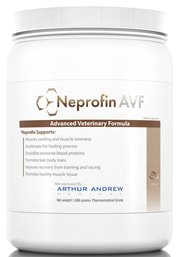 We receive questions daily regarding the products that we sell at Southwest Nutraceuticals, and many times we receive the same (or very similar) questions from different people. So, it got us thinking, what better place to share some of these questions and answers than our blog? We received an email from one of our customers about Neprofin AVF, which is an advanced veterinary formula for pain and inflammation in horses and even household pets, when given in smaller dosages. She writes, "I am interested in Neprofin AVF for my 10 yr. old Goldendoodle who is in good health. The human forms of these enzymes (ie. Neprinol, Vitalzym) all state it absolutely must be taken on an empty stomach - no food - or it will just digest the food and not go into the bloodstream. If the AVF product is put on an animal's food - how is it going to work properly? Answer: Neprofin AVF is considered a 'feed supplement' and is designed to be taken with food. A big part of the enzyme function in something like Neprofin is to assimilate food into nutrients and discard the waste. It works continuously with the pH variation of the digestive tract to increase digestion and absorption, which also intensifies absorption of released amino acids. This may lead to a reduction in swelling, quicker recovery from injuries, and an increase of lean muscle mass in the animal.
1 Comment
 Usually there is only a small amount of accumulated extra fluid in a dog's body [1]. However, conditions like congestive heart failure can cause a dog's body to become bloated and filled with liquid. Sometimes there is so much of this fluid that the dog's body weight can nearly double! Unfortunately this may be just the beginning. Heart problems can also trigger a secondary condition called canine protein-losing enteropathy (CPLE) that can cause even more fluid to build up, plus a host of other potentially life-threatening complications [2]. CPLE occurs when higher than normal amounts of protein leak into the intestinal tract and are lost through the stool. Although the dog's body tries to make up for this loss by producing more proteins like albumin, it can't keep up with the demand. As a result, the dog has low levels of albumin (hypoalbuminemia) and sometimes low levels of globulin (hypoglobulinemia). |
(800) 959-8872 (M-F: 7am - 4pm PST)
Copyright © 2004-2024 Southwest Nutraceuticals. All Rights Reserved.
Privacy Policy | Terms of Service
*These statements have not been evaluated by the Food and Drug Administration. This product is not intended to diagnose, treat, cure or prevent any disease.
For all conditions or illnesses, see a healthcare professional for a full evaluation, diagnosis or treatment plan.
Prices are subject to change without notice.
Privacy Policy | Terms of Service
*These statements have not been evaluated by the Food and Drug Administration. This product is not intended to diagnose, treat, cure or prevent any disease.
For all conditions or illnesses, see a healthcare professional for a full evaluation, diagnosis or treatment plan.
Prices are subject to change without notice.

 RSS Feed
RSS Feed

